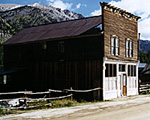
Some 25 miles south and west of Buena Vista, Colorado, the "ghost town" of St. Elmo sits high in the forested mountains of the San Isabel National Forest. Founded in 1871 as a miner's claim, it is still inhabited, at least part of the time, by "ghosts" who value four-wheel drive vehicles, bar-b-que grills, and satellite dishes. Yet, St. Elmo is typical of century-old mining towns and the 1880s-era buildings are slowly being restored.
The fog blanketing the mountains in San Isabel National Forest disappeared during a night of meteorological carnage usually reserved for movie special effects. The wind howled, the aspen trees thrashed back and forth, the temperature dropped, and the barometric pressure plummeted enough to make your ears pop. And that was what you could observe from the inside of a comfortable bed and breakfast inn. Outside was the domain of demented weathermen.
Yet the mayhem of night transformed into the peaceful calm of a glorious morning, with the sun seemingly hoisted from the horizon on the wings of angels—mere wisps of clouds streaming across an azure sky. The deep, dark green of spruce trees in the surrounding mountains framed the sky, while patches of aspen highlighted the panopy with golden brilliance. If you squinted, really squinted, in just the right spot and with just the right vista, the snow-capped peaks proved winter would not be long in coming to the Rockies. Indeed, the chilled air so crisp and pure announced that autumn would pluck at your cheeks and the tip of your nose while working visual magic upon your breath.
A sign along side the road contends you'll reach St. Elmo in 12 miles, and some seven miles from the ghost town, the pavement terminates with a slight bump in favor of a gravel road. It winds around massive boulders and through aspen and spruce, playing tag with the shadow of Mount Princeton, a 14,000-plus foot mountain making up one-quarter of the Collegiate Peaks—the others being Mount Harvard, Mount Yale, and Mount Columbia. Where the shadows live, the last vestiges of a snow storm from half a week ago remain to whiten the forest floor.
The "Ghost Town" of St. Elmo
St. Elmo rests wearily at the side of a meandering stream ricocheting off rocks on its decent into the canyon below. A yellow sign marks the entrance to the town, but instead of proclaiming population, founding date, or even the 9,000-foot elevation, it proudly says "Chipmunk Crossing." That's hardly the character of a Wild West ghost town, but it is an accurate indication of urban wildlife.
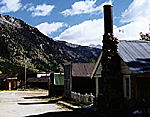 There are chipmunks everywhere, scampering across the street, running along a fence railing, and even sneaking into the first building you see in town--the General Store. This enthusiastic reception no doubt exists because bags of chipmunk food are for sale out front. If you are quiet enough and stationary, one of these bold fellows will shimmy up your pants leg looking for grub. Alas, they are a fickle lot, and will dart away on the double if someone else proffers a tasty tidbit.
There are chipmunks everywhere, scampering across the street, running along a fence railing, and even sneaking into the first building you see in town--the General Store. This enthusiastic reception no doubt exists because bags of chipmunk food are for sale out front. If you are quiet enough and stationary, one of these bold fellows will shimmy up your pants leg looking for grub. Alas, they are a fickle lot, and will dart away on the double if someone else proffers a tasty tidbit.
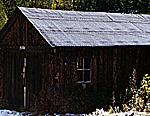 The ramshackle collection of buildings offers a monument to 1880s architecture, down to the wooden sidewalks, low windows, and high facades. You can amble through town in five minutes, the weathered wooden buildings still defiant to the elements after more than a century of wind, rain, and snow. Many, like the Miner's Exchange (now the General Store, but long ago also a bank and saloon) at the east edge of town and the Thorpe building and Maine house on the west edge of town, appear well maintained. Indeed, the "ghosts" who inhabit some of these buildings along Main Street value four-wheel drive vehicles, bar-b-que grills, and satellite dishes. Signs in the curtained windows warn away gawkers, asking the curious if they would enjoy camera-toting tourists peeking inside their houses.
The ramshackle collection of buildings offers a monument to 1880s architecture, down to the wooden sidewalks, low windows, and high facades. You can amble through town in five minutes, the weathered wooden buildings still defiant to the elements after more than a century of wind, rain, and snow. Many, like the Miner's Exchange (now the General Store, but long ago also a bank and saloon) at the east edge of town and the Thorpe building and Maine house on the west edge of town, appear well maintained. Indeed, the "ghosts" who inhabit some of these buildings along Main Street value four-wheel drive vehicles, bar-b-que grills, and satellite dishes. Signs in the curtained windows warn away gawkers, asking the curious if they would enjoy camera-toting tourists peeking inside their houses.
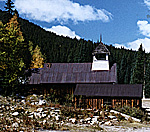
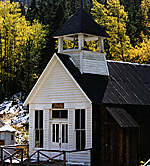 The town hall (photos right and left) boasts a cupola atop its roof housing a bell as well as a jail in the back of the building. The town reflects renovation work, wooden sidewalks look new, and even the outhouses in the rear of the buildings and away from Main Street look as solid as ever.
The town hall (photos right and left) boasts a cupola atop its roof housing a bell as well as a jail in the back of the building. The town reflects renovation work, wooden sidewalks look new, and even the outhouses in the rear of the buildings and away from Main Street look as solid as ever.
But other buildings tilt precariously into the breeze, partially demolished and boarded up. Open space between buildings provides vacant witness to what became of abandoned houses and stores. One storefront sign proclaims the American House Hotel parlour, but the rest of the hotel is lost to the elements of time.
Gold!
St Elmo owes its start to the discovery of gold near the then fledgling town of Denver in the 1850s. Within two decades, miners headed up the Chalk Creek Canyon in search of more veins. One of these miners, Dr. Abner Ellis Wright, is credited with being the first "settler" of the area in 1871. In 1875, Wright and a partner, John Royal, discovered a vein of ore just south of what would become St. Elmo. This vein, later developed into the Mary Murphy Mine, would eventually output $60 million worth of ore from 1875 to 1924 and become the magnet that attracted prospectors out for gold, silver, lead, and zinc, and the businesses that followed. In its heyday, St. Elmo boasted 50 mines, a half dozen saloons, a rail line, stagecoach line, hotels, an opera house, and an 18-piece band.
The town was originally called Forest City, apparently derived from the ubiquitous evergreen trees. However, the post office department objected to the name since there was already a Forest City, California. Sometime after 1880, the postmaster, Charles Seitz, a lawyer (perhaps T. Briscoe), and the mayor (Dr. Simmons), sat down to create another name. The lawyer proposed St. Elmo, which might have been because of a popular novel of the same name at that time, the mayor offered Irvington, and the postmaster sided with the lawyer. Irvington lost out (From Gold to Ghost: A History of St. Elmo, Colorado by Peter Anderson, 1991).
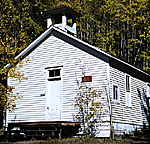 St Elmo's main street sits on the south side of Chalk Creek. The town is arranged in roughly a "T" shape, with Main Street being the cross bar and the stem pointing northward towards Tincup Pass, a half a dozen or so miles distant. A wooden bridge of recent construct allows passage across the creek, past cabins restored and collapsed, on the way to the white clapboard schoolhouse (at right), which had sometimes doubled as a church. In terms of entertainment, the schoolhouse's student shows, debates, and exhibitions were quite popular, especially around holiday times.
St Elmo's main street sits on the south side of Chalk Creek. The town is arranged in roughly a "T" shape, with Main Street being the cross bar and the stem pointing northward towards Tincup Pass, a half a dozen or so miles distant. A wooden bridge of recent construct allows passage across the creek, past cabins restored and collapsed, on the way to the white clapboard schoolhouse (at right), which had sometimes doubled as a church. In terms of entertainment, the schoolhouse's student shows, debates, and exhibitions were quite popular, especially around holiday times.
Typical Wild West Town
But a mining town in the 1880s came with its share of violence. Gambling and drinking led to fights and gunplay—sometimes fatal, most times not. Cattle rustlers frequented the high country pastures around St. Elmo. At one time, a local rustler led 30 heavily-armed cowboys ("with a repeating rifle studding the saddle boot and a big six-shooter in the holster") and 100 head of cattle (with "botched up brands") through St. Elmo. A few years later, "officers from outside counties" raided the St. Elmo area, nabbing some cattle rustlers and their help, perhaps even the same ones. Robberies also occurred, in part because the rugged terrain offered multiple escape routes. In one example, two masked men entered Pat Hurley's saloon with guns drawn, robbed the patrons, then backed out the door and escaped. However, after the early boom years of the 1880s, and perhaps in part because the town put a sheriff on payroll by 1890, crime diminished rapidly and St. Elmo became a rather peaceful community (From Gold to Ghost: A History of St. Elmo, Colorado).
Through boom and bust cycles, the little town struggled on through the turn of the century and into and out of World War I. The decline of mining in the area eventually hurt prospects, but when the Colorado and Southern Railroad shut down its Chalk Creek extension line to St. Elmo and pulled up the tracks in 1926, the town largely expired.
Today, the road to St. Elmo boasts a number of fishing areas and hiking trails, as backpackers, hikers, and campers roam the hills where miners once toiled underground. On a clear autumn day, the drive to St. Elmo offers breathtaking scenery, with a walk around town, if not a short foray into the hills, worth the diversion.
Getting to St. Elmo:
Buena Vista, CO, is about 100 miles southwest of Denver on State Hwy 24 and is the nearest sizeable town to St Elmo (which is about 25 miles from Buena Vista). It has one stop light at the intersection of 24 and Main St. If you are heading east on 24 (from Leadville towards Colorado Springs), turn right at the light. Go a half mile through residential area and turn left onto County Hwy 321. Take that about 8 miles across the flat plain and then down into the canyon. At the Stop sign, turn right and go approximately 15 miles until you reach St. Elmo.
Lodging
Buena Vista boasts numerous local motels and at least one chain motel (Super 8), plus a number of bed and breakfast inns in and around the town. There are also a number of B&Bs on the road to St. Elmo, technically inside San Isabel National Forest.
Recommended: The Streamside B&B (18820 CR 162, Nathrop, CO 81236, 719-395-2553), about 12 miles from Bueva Vista and on the road to St. Elmo. Follow the directions from BV to St. Elmo—the B&B will be on the left. Hosts Denny and Kathy Claveau have three rooms available in an outbuilding from their main home. Our room came with a comfortable queen size poster bed, a rocking chair for reading, table with two other chairs, and a bathroom with shower stall. Two of the rooms include a small outdoor decking. Breakfast was a prodigious display of home cooking with pancakes, eggs, sausage, tea, coffee, orange juice, and some other goodies. Pricing is $64 to $69 a night.
Dining in Buena Vista:
An array of local and fast food restaurants are available along State Hwy 24.
Recommended: A local Mexican restaurant (downstairs, with a Sports bar upstairs) on Main Street called El Duran's. This is a local hangout with an aging interior, so if decor matters more to you than food, go elsewhere. Hearty servings of tacos, enchiladas, and other fare are provided with a friendly smile. Pricing is under $10 per entre.
Back to List of Historical Sites
© Copyright 1996 by Coalition Web, Inc.
This article appears in MagWeb (Magazine Web) on the Internet World Wide Web.
Other military history articles and gaming articles are available at http://www.magweb.com